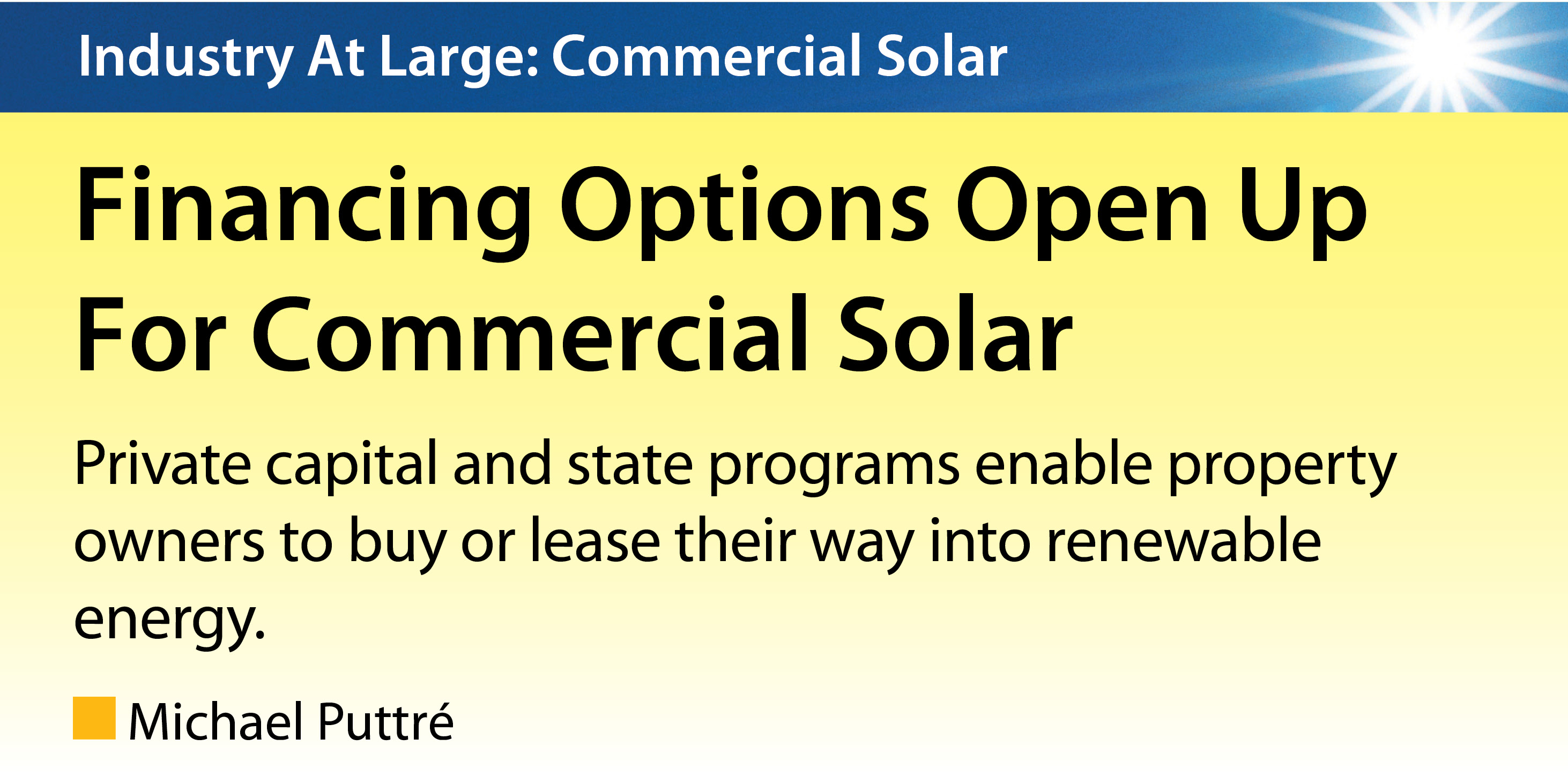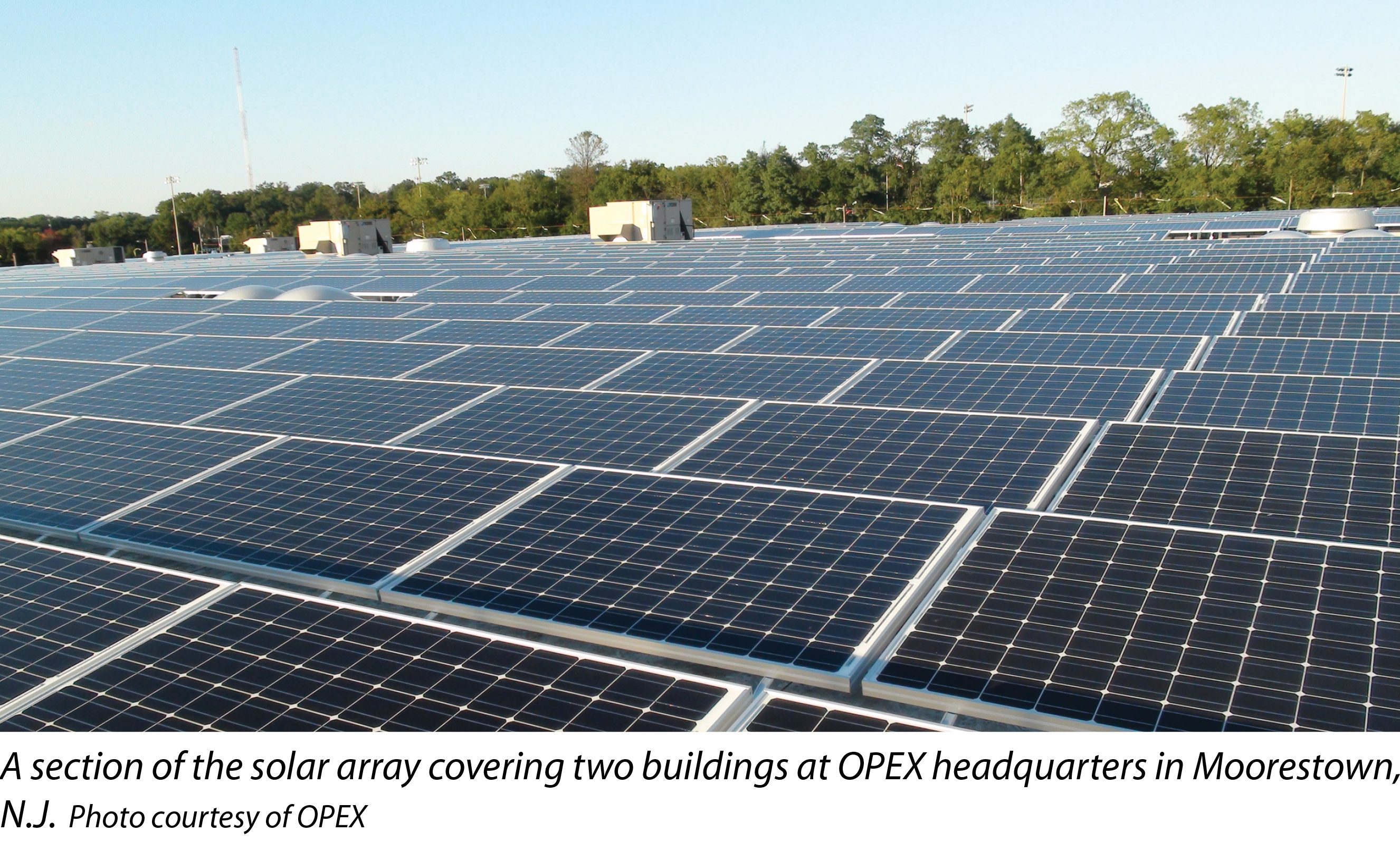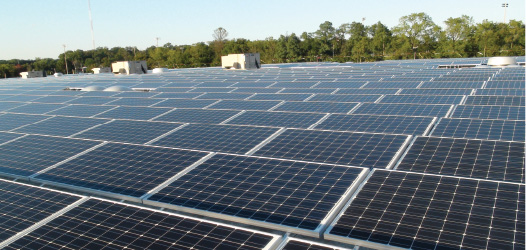

301 Moved Permanently
The commercial solar market used to be in the nether regions of the industry. Bigger than a housetop and smaller than a desert floor, commercial solar falls in between residential programs and projects large enough to take a bite out of a state’s renewable portfolio standard.
Perhaps the biggest problem with commercial solar is that a large number of businesses lease the facilities they operate from. Solar developers, and especially financiers, want the owner’s stamp of approval. And where’s the incentive? The electric bills are either paid by the tenant or reflected in the rent. What does the owner need solar for?
Yet as a new year swings around and 2017 gets ever closer, the commercial solar market in the U.S. is experiencing a fairly dramatic upswing. Christine Beadle, analyst at NPD Solarbuzz, says that with just three years remaining until the full tax credit incentive rate declines, solar PV project developers in the U.S. are planning to complete projects, or have a significant portion under construction, prior to the deadline. This deadline is causing a shift in focus to smaller projects that can be completed on shorter timescales, she says.
According to a 2013 report by the Solar Energy Industries Association (SEIA) on commercial solar power usage, the 25 companies with the highest total solar capacity had deployed more than 445 MW at over 950 different facilities as of August 2013. The figures were up from the 2012 report, in which the top 25 companies were listed as having installed just over 300 MW at 730 facilities. The latest report said cumulative commercial deployment totaled 3.38 GW at over 32,800 facilities as of the middle of 2013 - an increase of more than 40% over the previous year.
Taking the plunge
Solar installer Energy Systems & Installation (ESI) of Jonestown, Pa., says it worked with STULZ Air Technology Systems to design and install a large commercial array. In an ESI blog post about the installation, Thorstein Weiss, chief financial officer of STULZ, pointed out how the investment in renewable energy fit with the image the company wanted to project about itself: “Working with ESI has given STULZ the opportunity to not only see improved energy efficiency in its facility, but also to realize the same green philosophy that STULZ offers in our products.”
The Frederick, Md.-based producer of data center cooling systems says its products reduce energy usage and, therefore, the carbon footprint of its customers. Moreover, the company says the 951 kW rooftop array reduced electricity costs by 70%. At current rates, STULZ expects to have recouped its investment in the array in less than five years.
OPEX Corp., a Moorestown, N.J.-based maker of high-speed mail handling, document management and warehouse automation systems, has installed a 2.4 MW solar power system capable of producing more than 100% of the electricity needed to operate its 250,000 square-foot manufacturing, distribution and administrative complex, effectively making it a net-zero user of electricity. While OPEX readily admits that the outlay for its extensive rooftop and ground-mount solar arrays is “not insignificant,” the company says the returns on this investment in the form of utility bill savings and preservation of the environment make it a “worthwhile and prudent use of OPEX capital.”
Long Island, N.Y.-based SUNation Solar Systems Inc. has completed the first 388 kW phase of a two-array rooftop project for IVY Enterprises Inc. of Port Washington, N.Y. Construction of an adjacent building is under way that will support a 329 kW photovoltaic system when complete. According to Scott Maskin, SUNation president and CEO, commercial projects require serious commitment on the parts of both installer and customer.
“Commercial projects require a committed owner,” Maskin says. “These projects can be so fragile. You must have a good relationship with the customer in order to proceed.”
By fragile, Maskin refers to the myriad problems that could cause a commercial building owner to pull out - from zoning and codes, to changes in the incentives on offer. Because commercial projects require a serious investment in resources and material on the part of the installer, such a result could be ruinous.
Perhaps the most high-profile of the owner-operator school of commercial solar is IKEA, which last year hit its goal of completing solar installations atop 39 out of 44 of its U.S. locations, with a total capacity of 38 MW. IKEA eschews solar leasing programs and power purchase agreements (PPAs). The company owns and operates each of its solar PV energy systems. As a global endeavor, IKEA has allocated $1.8 billion to invest in renewable energy through 2015 and has the goal of being energy independent company-wide by 2020.
“At IKEA, we believe in creating a better life for the many people, so investing in renewable energy helps contribute to that goal,” says Richard Castanon, store manager of IKEA’s Charlotte, N.C., location, on the occasion of its 1 MW array becoming the chain’s number 39 U.S. solar installation.
In addition to a desire to project its “Swedish heritage and respect of nature,” the company has a business interest in developing its expertise as an owner of solar power systems. IKEA and China-based solar energy firm Hanergy are partnering to market photovoltaic systems, along with installation and financing services, in the U.K. IKEA says all 17 of its U.K. stores will soon be selling solar energy systems and services. Hanergy Solar U.K. will provide IKEA customers with an in-store consultation and design services, as well as installation, maintenance and monitoring.
Leased but not last
Companies seeking to burnish their green credentials with solar power do not always feel compelled to take on the mantle of owner-operator. Walmart, which tops SEIA’s list of top U.S. commercial installers of 2013, with 89.43 MW installed at 215 locations, buys the output of the arrays from owner-operators through PPAs. For example, the retail giant signed a deal with Greenskies Renewable Energy LLC to build and own 2.7 MW of capacity on eight stores in Massachusetts. In Ohio, Walmart partnered with SolarCity to install 4.5 MW of solar arrays at 12 stores. In both cases, Walmart avoids the upfront costs and buys the power.
In June of last year, Walgreens contracted with SoCore Energy to build more than 200 new solar installations at its locations in California, Connecticut, Delaware, Massachusetts, New Jersey and New York. SoCore will own the installations, and Walgreens will purchase the electricity through long-term PPAs. The drugstore chain has also worked with SunEdison and SolarCity under similar arrangements. SunEdison says most retailers lease their solar arrays.
“Leasing is interesting, particularly when the developer has no equity or wherewithal,” says Andrew Redinger, managing director and head of KeyBanc Capital Markets’ utilities, power and renewables group. “He’s got no money, but he’s got a site.”
Nobody would expect to find anything but lint in Walmart’s out-turned pockets. However, box stores have acres of solar-friendly real estate up on the roofs. Becoming an owner-operator requires a commitment to develop suitable in-house expertise that may not be in the business plan or corporate vision.
Fort Washington, Pa.-based solar developer and installer Tecta Solar says “green” properties are highly attractive to developers, owners, operators, retailers, municipalities and consumers. Jay Levin, director of operations for Tecta Solar, says companies have to take a hard look at their strategic goals and capabilities before taking on not just the upfront costs of construction but also the burden of operations and maintenance (O&M) for a commercial solar facility.
“And will you wash those thousands of dusty solar panels or just wait for the next rainfall?” Levin says. “If you ask yourself the same question when it’s time to wash your car, then you may want to hire someone else for O&M. If you choose to self-perform your solar O&M, be sure to budget time accordingly for yourself or your employees who are handling this task. Many systems run smoothly for extended periods of time, but when they do have performance issues, the drain on resources can be quite taxing.”
Fortunately, says KeyBanc’s Redinger, the economic conditions for outsourcing commercial solar ownership and O&M are becoming very favorable. For many commercial enterprises, the best way into solar is the leasing route, and the sector has seen the advent of sources of capital that will provide 100% of the financing. Moreover, partnerships between developers and financiers essentially provide one-stop shopping for prospective commercial solar customers.
“The only problem is that you don’t own it,” Redinger says. “When the lease ends, you have to buy the project back.”
Lending a hand
Perhaps inevitably, states that wish to see a thriving marketplace for commercial solar often step in to offer stability in what one official describes as a “wild west” financing situation. In January 2013, Connecticut’s Clean Energy Finance and Investment Authority (CEFIA) launched the Commercial and Industrial Property Assessed Clean Energy (C-PACE) program to help building owners obtain low-cost, long-term, upfront financing for clean energy upgrades, including the installation of commercial solar power systems. Upgrades eligible for financing must lower the energy consumption of the building or enable the building to produce clean energy.
Owners of commercial, industrial or multifamily (five-family or more) dwellings in good standing tax-wise are eligible to participate. CEFIA says the financing program is best-suited for capital improvements that cost more than $150,000. The cost of clean energy improvements is added to tax bills as an additional charge so is paid for over time. Moreover, if the property is sold, the repayment obligation transfers automatically to the new owner.
“The assessment is tied to the property, so it is packaged with the sale,” says Bert Hunter, CEFIA’s chief investment officer. “The C-PACE assessment must be paid - it comes right after the property assessment in order of obligation. We can foreclose on you if you don’t pay your assessment.”
Hunter says the program is providing benefits to building owners who might otherwise be priced out of the solar market. For example, the owner of an office facility in Middletown, Conn., received financing of $2,535,766 to construct a 260 kW solar photovoltaic system and energy efficiency improvements. The improvements are expected to result in energy savings of 65% and cost savings of approximately $192,000 per year.
Lower down the scale, the owner of a 34,500 square-foot building in Hartford, Conn., originally constructed in 1925 and renovated in 2008 for its current usage as an office space and warehouse facility, received $145,000 in construction financing through the C-PACE program, covering 100% of project costs, to install a 55 kW solar photovoltaic system mounted on the building’s roof.
Hunter says Connecticut adopted the C-PACE program to support installers who wanted to enter the commercial solar sector but were unable to secure financing from banks. The program is targeting 50 kW to 300 kW commercial installations. Hunter points out that typical commercial installations range between $300,000 to $400,000 - beyond the consideration for most commercial property owners and solar installers in the state. While vertically integrated developers such as SolarCity and SunRun are entering the Connecticut market, Hunter says the goal of C-PACE is to maintain a competitive marketplace for commercial solar financing.
“The installers wanted it,” he says. “We want to break down the barriers getting in the way of the marketplace.”
CEFIA has approved over $15 million in C-PACE financing since its launch. It has retained Reznick Capital Markets Securities to manage the fund. U.S. Bank is participating as the tax equity investor, in addition to a syndicate consisting of four regional lenders led by First Niagara Financial Group. Assurant Inc. is providing an insurance bundle and warranty management program.
The origins of the commercial leasing program began with a fund Connecticut started with U.S. Bank in 2008 to support residential leases. The fund, which had $33 million, provided for 855 residential solar leases, Hunter says. When the program ran dry in 2011, it was reconstituted as the Connecticut Green Bank.
New York also has a Green Bank program. To capitalize the program, the New York State Energy Research and Development Authority filed a petition with the New York Public Service Commission (PSC) to redirect approximately $165 million in uncommitted funds from the energy efficiency portfolio standard and the renewable portfolio standard. If the PSC rules in favor of the petition, the N.Y. Green Bank is expected to have $1 billion in funds when fully capitalized, to finance renewable energy development.
SolarConnecticut, an advocacy group, says Connecticut will lower the installed cost of commercial solar and is expected to attract more competitive bidders to the state’s electric ratepayer incentivized Zero-Emission Renewable Energy Credit (ZREC) program. The law, signed last June by Gov. Dannel P. Malloy, makes photovoltaic electric and solar heating and cooling systems installed in the state after the first of this year exempt from property taxes. Residential PV systems are already exempt from property tax in the state.
New York has also enacted a law exempting sales and installations of commercial solar units from the 4% state sales and use tax. Residential solar equipment in New York gained a similar tax exemption in 2005.
CEFIA’s Hunter says the ZREC program is the cornerstone of his state’s support for commercial solar financing. Unlike solar renewable energy certificates (SRECs), whose value is prone to market fluctuations and even crashes, a ZREC is purchased at auction and represents a solid contract.
“The holder of a ZREC has a guaranteed source of revenue,” Hunter says. “It’s bankable and enables the owner to use the tax benefits.”
While state-subsidized programs such as C-PACE have a role in promoting residential solar, ideally governments would like to pave the road and then get out of the way.
Sol Systems, a financial services firm specializing in residential and commercial solar development, formed a partnership with Alta Energy last November to offer third-party financing of solar projects for commercial and industrial property owners. Alta Energy will perform site analysis and procurement services. Sol Systems will provide due diligence and project financing services. The partnership hopes to make solar projects attractive options for commercial and industrial property owners.
Hanwha Q CELLS USA is increasing its capabilities in the commercial rooftop segment with the addition of a commercial division within the company. Hanwha Q CELLS says it is offering a one-stop solution for bankable commercial systems, from initial assessment to ongoing operation. The company says it will provide development; engineering, procurement and construction services; O&M services; and project financing through its Hanwha Group parent.
Interestingly, a report by IHS predicts that concerns about energy rates and grid reliability in the North American commercial solar market will increase demand for commercial PV storage. The report says North America will account for more than 40% of worldwide PV commercial storage installations by 2017. The growing demand for PV storage by business owners indicates that commercial solar’s time has come. R
Industry At Large: Commercial Solar
Financing Options Open Up For Commercial Solar
By Michael Puttré
Private capital and state programs enable property owners to buy or lease their way into renewable energy.


si body si body i si body bi si body b
si depbio
- si bullets
si sh
si subhead
pullquote
si first graph
si sh no rule
si last graph